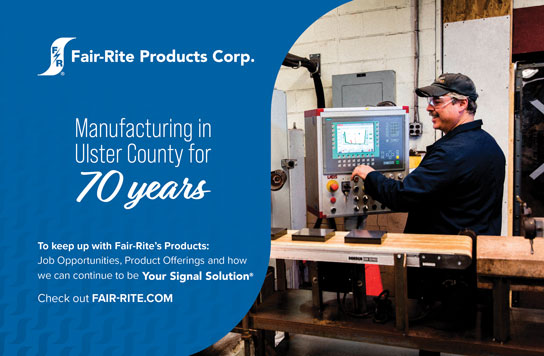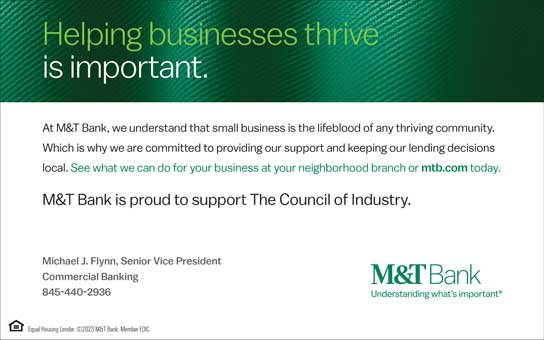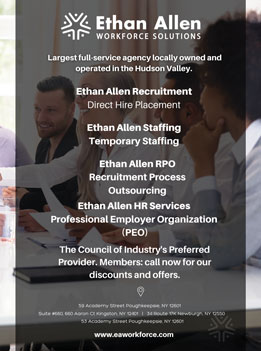the effects of the great people shortage on the hudson valley

The leading edge of this trend is hitting us now, and the symptoms are everywhere.
Hospital executives cannot find enough local nurses, forcing them to hire contract nurses from elsewhere at double or triple the cost. At least three school districts in our region have eliminated some bus routes because they cannot find enough drivers. Many restaurants have posted signs that ask their customers for patience because they are short on kitchen and wait staff.
My hometown last year posted a help-wanted ad for an operator at the wastewater treatment plant, but six months later we had exactly zero applications. Years after being constructed, many of the new warehouse and shipping centers across the region still have A-frame signs on the highway soliciting employees and promising large signing bonuses.
All these are symptoms of shrinkage in our regional labor pool.

Earlier this year, our research team at Hudson Valley Pattern for Progress investigated this trend and published a report – The Great People Shortage and its Effects on the Hudson Valley – to underscore the demographic forces that are causing our labor stress.
“The Great People Shortage” is a phrase coined by economists who are tracking a global trend of declining births in all the major industrialized countries, including China, Germany, the United Kingdom, and the United States. To keep global and local populations flat, families must have an average of 2.1 children. The birth rate in all the industrialized countries has dropped below that threshold in recent decades. Here in New York, our families are averaging 1.55 children – a number that points to relatively significant population decline in the decades ahead.
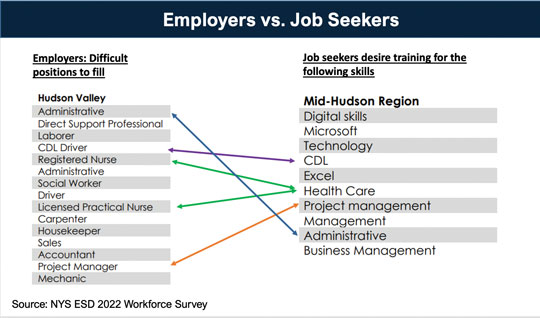
On a net basis, the Hudson Valley now has 3,000 fewer annual births than it did in 1997. Most of our counties have seen their births drop by 20-35 percent during that time. For example, families in Dutchess County had 3,399 babies in 1997. Births dropped steadily over two decades, and by 2019 families in Dutchess only had 2,699 children, 700 fewer than a generation ago.
The trend of fewer births has resulted in plummeting school enrollments across the Hudson Valley. Over the past 25 years, school enrollment across the region has dropped by 34,088 children. There are 120 school districts in the Hudson Valley, and 97 of them are currently shrinking. In fact, every school district in the counties of Columbia, Dutchess, Greene, Putnam and Ulster have seen their enrollments decline since 2007. The majority of school enrollments in Orange, Rockland, Sullivan and Westchester are also shrinking significantly.
Despite these trends, we still hear people opposing direly needed housing projects by yelling that “we cannot afford to have more children in the schools.” This bizarre rallying cry is nonsense, and those who carry this myth to planning board meetings are only advocating for our communities to hollow out as kids become fewer and fewer. We should always consider legitimate opposition to land-use projects in our region, but the misguided argument against kids should be corrected and dismissed at the door.
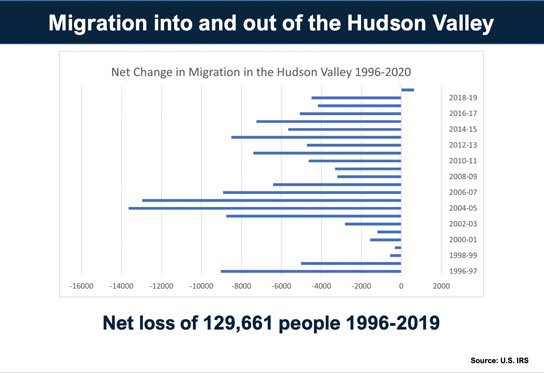
The trend of fewer births across the Hudson Valley is paired with a second problem: more people have moved out of our region than into it for 24 of the past 25 years. During that time, the Hudson Valley has lost a net of 134,505 people to outward migration. (Migration is the movement of people county-to-county, and state-to-state across the United States.) Most people leaving the region in the 2020s are moving just over the border to neighboring states like New Jersey or Pennsylvania, or heading south to Florida and the Carolinas. When movers from the Northeast were surveyed by the U.S. Census Bureau, they cited housing as the No. 1 reason for leaving our area.
Fewer births, outward migration, and a wave of retirements among workers in the Baby Boomer generation have yielded a workforce crisis that is being felt across every industry sector in the Hudson Valley.
Population data and projections underscore that our labor pool is getting smaller and smaller.
Our research team analyzed the number of people in the Hudson Valley between the ages of 25-64. The cohort of people ages 45-64 outnumbers the younger half, ages 25-44, by 99,770 people. What does that mean? For every person who retires in the Hudson Valley, we only have a fraction of a person entering the workforce behind them. As the decades pass, this trend will shrink the pool of people from which our businesses can draw workers.
Unfortunately, data show this problem will worsen over the next 20 years. The number of infants, children and teenagers living in the region has also dwindled considerably over the past decade. In fact, there were 26,335 fewer children and teens living in our region in 2021 compared to 2010. That trend – a consequence of lower births and families leaving the region – points directly to fewer workers in the future.
The great people shortage in the Hudson Valley comes with real consequences for our communities, businesses, and civic society.
The labor shortages we feel now will become worse. The trend toward fewer people also means fewer customers, which could lead to small-business closures and other consequences. The Hudson Valley has been very successful at attracting businesses to the region over the past 20 years, but local, national and international companies will not continue to set roots in the region if we do not have an ample supply of well-trained workers.
Our people shortage will pressure school districts to close additional buildings as enrollments drop, and stretch thin the group of volunteers who serve in our fire districts, ambulance corps, and Little Leagues. Our aging population in the Hudson Valley means that more and more people need healthcare services, but our shrinking workforce is yielding fewer and fewer people to work in that industry, creating a tension between demand for healthcare and the supply of people to work as nurses, doctors and lab techs.
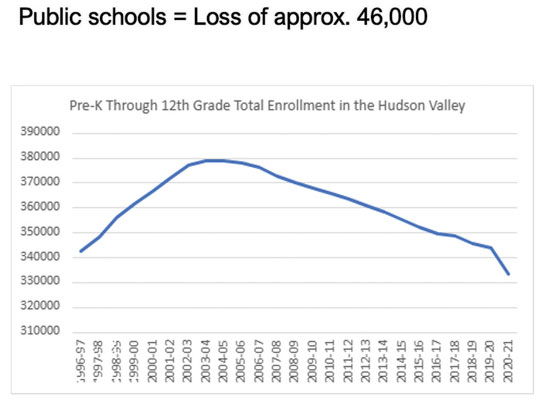
Paired with our housing crisis and climate change, the great people shortage will likely be the defining challenge for the Hudson Valley over the next two decades. The solutions are not easy, obvious, or guaranteed to work, but there are some common-sense actions that require the attention of our leaders in every corner of civic society.
Housing is imperative. We do not have enough housing. The housing we have is too expensive for most of our neighbors. And our local codes and review processes make it very difficult to build more of the housing we direly need. Unless we can unlock the market and incentivize the development of housing for people across the entire spectrum of income and need, our people will continue to move to other places that offer affordable apartments and starter homes. Both are endangered housing species that are nearing extinction in the Hudson Valley.
Taxes are a second challenge. People who move just over the border to neighboring states save anywhere from $2,800 to $4,000 on property taxes for a home valued at $400,000. Those who move south save $6,400-$8,000. New York has not entertained a serious discussion about property taxes since state lawmakers adopted a tax cap more than a decade ago. People who care about their wallets are voting with their feet and going elsewhere.
People should never avoid bad news about their health or their finances.
It is a cruel coincidence that human nature is to avoid both.We cannot let that happen in the Hudson Valley. The great people shortage
drives directly to the core of our regional health and economy in too many ways.
Let’s see these trends with open eyes and open minds, and work together
on evidence-based solutions that can alleviate them.
Two other opportunities hold some promise.
Higher education is the second largest industry cluster in the Hudson Valley. Tens of thousands of young people come to study at our colleges and universities every year, but the region does not have a coherent plan to reach those young people, introduce them to jobs in the region, and convince them to stay. Empire State Development, SUNY, I LOVE NY, and workforce experts should collaborate on a comprehensive plan to keep college students here and connect them with employers who need them.
As we confront our people shortage, it is also important to acknowledge that births, migration, and immigration are the only three factors that can flatten our downward trend. Experts interviewed for our research took a particular interest in immigration. With births steadily lower and migration pointing outward for more than two decades, immigration might be our only chance to fill the widening gap in our labor force. It is frustrating we have no state or local control over immigration, but we should certainly pester our federal representatives to work toward a more rational, organized system that could bring the next generation of immigrant Americans into our region.
I will admit it. The data look gloomy.
I remember once listening to a radio interview with an economist who said that people should never avoid bad news about their health or their finances. It is a cruel coincidence that human nature is to avoid both.
We cannot let that happen in the Hudson Valley. The great people shortage drives directly to the core of our regional health and economy in too many ways. Let’s see these trends with open eyes and open minds, and work together on evidence-based solutions that can alleviate them.



